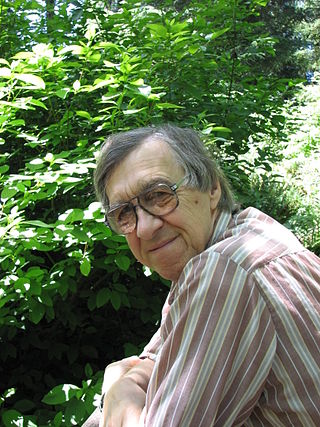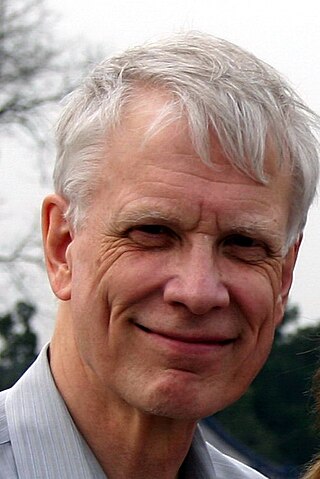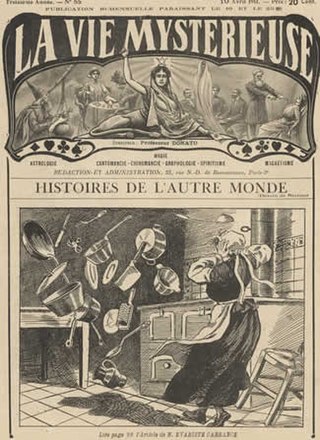Related Research Articles

Clairvoyance is the claimed ability to acquire information that would be considered impossible to get through scientifically proven sensations, thus classified as extrasensory perception, or "sixth sense". Any person who is claimed to have such ability is said to be a clairvoyant.

Parapsychology is the study of alleged psychic phenomena and other paranormal claims, for example, those related to near-death experiences, synchronicity, apparitional experiences, etc. Criticized as being a pseudoscience, the majority of mainstream scientists reject it. Parapsychology has also been criticized by mainstream critics for claims by many of its practitioners that their studies are plausible despite a lack of convincing evidence after more than a century of research for the existence of any psychic phenomena.

Telepathy is the purported vicarious transmission of information from one person's mind to another's without using any known human sensory channels or physical interaction. The term was first coined in 1882 by the classical scholar Frederic W. H. Myers, a founder of the Society for Psychical Research (SPR), and has remained more popular than the earlier expression thought-transference.

A psychic is a person who claims to use powers rooted in parapsychology such as extrasensory perception (ESP) to identify information hidden from the normal senses, particularly involving telepathy or clairvoyance, or who performs acts that are apparently inexplicable by natural laws, such as psychokinesis or teleportation. Although many people believe in psychic abilities, the scientific consensus is that there is no proof of the existence of such powers, and describes the practice as pseudoscience. The word "psychic" is also used as an adjective to describe such abilities.

An out-of-body experience is a phenomenon in which a person perceives the world from a location outside their physical body. An OBE is a form of autoscopy, although this term is more commonly used to refer to the pathological condition of seeing a second self, or doppelgänger.

Alfred Rupert Sheldrake is an English author and parapsychology researcher. He proposed the concept of morphic resonance, a conjecture that lacks mainstream acceptance and has been widely criticized as pseudoscience. He has worked as a biochemist at Cambridge University, a Harvard scholar, a researcher at the Royal Society, and a plant physiologist for ICRISAT in India.

Susan Jane Blackmore is a British writer, lecturer, sceptic, broadcaster, and a visiting professor at the University of Plymouth. Her fields of research include memetics, parapsychology, consciousness, and she is best known for her book The Meme Machine. She has written or contributed to over 40 books and 60 scholarly articles and is a contributor to The Guardian newspaper.

Remote viewing (RV) is the practice of seeking impressions about a distant or unseen subject, purportedly sensing with the mind. A remote viewer is expected to give information about an object, event, person, or location hidden from physical view and separated at some distance. Physicists Russell Targ and Harold Puthoff, parapsychology researchers at Stanford Research Institute (SRI), are generally credited with coining the term "remote viewing" to distinguish it from the closely related concept of clairvoyance. According to Targ, the term was first suggested by Ingo Swann in December 1971 during an experiment at the American Society for Psychical Research in New York City.
Paranormal events are purported phenomena described in popular culture, folk, and other non-scientific bodies of knowledge, whose existence within these contexts is described as being beyond the scope of normal scientific understanding. Notable paranormal beliefs include those that pertain to extrasensory perception, spiritualism and the pseudosciences of ghost hunting, cryptozoology, and ufology.

Ray Hyman is a Professor Emeritus of Psychology at the University of Oregon in Eugene, Oregon, and a noted critic of parapsychology. Hyman, along with James Randi, Martin Gardner and Paul Kurtz, is one of the founders of the modern skeptical movement. He is the founder and leader of the Skeptic's Toolbox. Hyman serves on the Executive Council for the Committee for Skeptical Inquiry.
In American science fiction of the 1950s and '60s, psionics was a proposed discipline that applied principles of engineering to the study of paranormal or psychic phenomena, such as extrasensory perception, telepathy and psychokinesis. The term is a blend word of psi and the -onics from electronics. The word "psionics" began as, and always remained, a term of art within the science fiction community and—despite the promotional efforts of editor John W. Campbell, Jr.—it never achieved general currency, even among academic parapsychologists. In the years after the term was coined in 1951, it became increasingly evident that no scientific evidence supports the existence of "psionic" abilities.
The Institute of Noetic Sciences (IONS) is an American non-profit parapsychological research institute. It was co-founded in 1973 by former astronaut Edgar Mitchell, the sixth man to walk on the Moon, along with investor Paul N. Temple and others interested in purported paranormal phenomena, in order to encourage and conduct research on noetics and human potentials.
Dean Radin investigates phenomena in parapsychology. Following a bachelor and master's degree in electrical engineering and a PhD in educational psychology Radin worked at Bell Labs, as a researcher at Princeton University and the University of Edinburgh, and was a faculty member at University of Nevada, Las Vegas. He then became Chief Scientist at the Institute of Noetic Sciences (IONS) in Petaluma, California, USA, later becoming the president of the Parapsychological Association. He is also co-editor-in-chief of the journal Explore: The Journal of Science and Healing. Radin's ideas and work have been criticized by scientists and philosophers skeptical of paranormal claims. The review of Radin's first book, The Conscious Universe, that appeared in Nature charged that Radin ignored the known hoaxes in the field, made statistical errors and ignored plausible non-paranormal explanations for parapsychological data.

Charles T. Tart is an American psychologist and parapsychologist known for his psychological work on the nature of consciousness, as one of the founders of the field of transpersonal psychology, and for his research in parapsychology.
Ingo Douglas Swann was an American psychic, artist, and writer known for being the co-creator, along with Russell Targ and Harold E. Puthoff, of remote viewing, and specifically the Stargate Project.

James E. Alcock is Professor emeritus (Psychology) at York University (Canada). Alcock is a noted critic of parapsychology and a Fellow and Member of the Executive Council for the Committee for Skeptical Inquiry. He is a member of the Editorial Board of The Skeptical Inquirer, and a frequent contributor to the magazine. He has also been a columnist for Humanist Perspectives Magazine. In 1999, a panel of skeptics named him among the two dozen most outstanding skeptics of the 20th century. In May 2004, CSICOP awarded Alcock CSI's highest honor, the In Praise of Reason Award. The author of several books and peer reviewed journal articles, Alcock is also an amateur magician and a member of the International Brotherhood of Magicians.

Banachek is an English mentalist, magician, and "thought reader".

Telekinesis is a hypothetical psychic ability allowing an individual to influence a physical system without physical interaction. Experiments to prove the existence of telekinesis have historically been criticized for lack of proper controls and repeatability. There is no reliable evidence that telekinesis is a real phenomenon, and the topic is generally regarded as pseudoscience.

Caroline Watt is a Scottish psychologist and professor of parapsychology. She is the holder of the Koestler Chair of Parapsychology at the University of Edinburgh. She is a past president of the Parapsychological Association. She is an author of several papers and books on parapsychology and runs an online course that helps educate the public about what parapsychology is and to think critically about paranormal claims.

Paranormality: Why we see what isn't there is a 2011 book about the paranormal by psychologist and magician Richard Wiseman. Wiseman argues that paranormal phenomena such as psychics, telepathy, ghosts, out-of-body experiences, prophesy and more do not exist, and explores why people continue to believe, and what that tells us about human behavior and the way the brain functions. Wiseman uses QR codes throughout the book, which link to YouTube videos as examples and as experiments the reader can participate in to further explain the phenomena. Because of a cautious American publishing market, it was only available in America through Kindle. Paranormality was awarded the Center for Inquiry's Robert P. Balles award for 2011.
References
- ↑ Twist, Jo (18 May 2004), New expression for virtual city, BBC, retrieved 12 January 2012
- ↑ Lecture – Out-of-Body Experiences – In Search of the Truth – Graham Nicholls, The Society for Psychical Research, 2013, archived from the original on 18 July 2013, retrieved 20 July 2013
- ↑ CATS College Cambridge students at the world-famous Cambridge Union, CATS College, 2011, archived from the original on 5 January 2012, retrieved 12 January 2012
- ↑ Graham Nicholls Interview, Myartspace.com, 2008, retrieved 1 October 2009
- 1 2 Graham Nicholls Video Artist (PDF), Xfuns Magazine, 2007, archived from the original (PDF) on 18 December 2008, retrieved 1 October 2009
- ↑ Oddey, Alison; White, Christine A. (June 2006). The potentials of spaces: the theory and practice of scenography and performance. ISBN 9781841501376.
- ↑ Oddey, Alison (June 2006). Re-Framing the Theatrical: Interdisciplinary Landscapes for Performance. p. 206. ISBN 9780230524651.
- ↑ Ginsburgh, Victor (November 2006). Handbook of the economics of art and culture, Volume 1. p. 1162. ISBN 978-0-444-50870-6.
- ↑ Anna Pukas (14 July 2011). "Out of their minds?". Daily Express.
- ↑ Graham Nicholls LCS Interview, London College of Spirituality, 2009, archived from the original on 17 July 2011, retrieved 1 October 2009
- 1 2 3 Art and Science: The Truth Behind Telepathy, Spoonfed, 2009, archived from the original on 8 September 2009, retrieved 1 October 2009
- ↑ Nicholls, Graham (October 2011). "Out-of-Body Experiences: In Search of the Truth". Noetic Now (15). USA: The Institute of Noetic Sciences.
- ↑ Kearns, Anne (October 2012). "Review of Navigating the Out-of-Body Experience: Radical New Techniques". The Psychologist. 25 (10). Leicester, England: The British Psychological Society: 765. ISSN 0952-8229.
- ↑ Make Poverty History Official Members, Make Poverty History, 2005, archived from the original on 23 May 2005, retrieved 23 August 2011
- ↑ Anapol, Deborah (January 2012). Polyamory in the 21st Century: Love and Intimacy with Multiple Partners. pp. 205–6. ISBN 978-1442200227.
- ↑ "Meet the polyamorists – a growing band of people who believe". The Independent. 13 September 2009.
- ↑ Graham Nicholls interview with Elisabeth Haljas (Estonia), fruitarians.net/, 2010, archived from the original on 19 October 2011, retrieved 20 July 2013